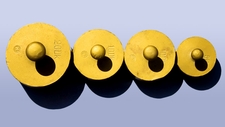Mass

TEKS Objective
The student is expected to measure, test, and record physical properties of matter, including temperature, mass, magnetism, and the ability to sink or float.
Essential Understanding
The student knows that matter has measurable physical properties and those properties determine how matter is classified, changed, and used.
Science Background
Weight and Mass: University of Colorado (website) - Explains the difference between weight and mass.
Weight and Mass
University of Colorado, www.colorado.edu
Mass vs. Weight: NASA Stennis Space Center (website) - Information, poster and activities focused on mass and weight.
Mass vs. Weight
NASA Stennis Space Center, www.education.ssc.nasa.gov
Signature Lesson
Worth the Weight: Utah Education Network (website) - Students practice measuring weight in grams and kilograms.
- Supporting Lessons
- Extensions
- Assessment Ideas
- Literature Connections
- Related
TEKS - Additional Resources
Supporting Lessons
Your Weight on Other Worlds: Exploratorium (website) - Interactive calculator determines what your weight would be on other planets.
Your Weight on Other Worlds
Exploratorium, www.exploratorium.edu
Elaboration Lessons and Extensions
Center of All Things: NASA Stennis Space Center (PDF) - Students use a plumb to deduce the center of mass of irregular shapes.
Center of All Things
NASA Stennis Space Center, www.education.ssc.nasa.gov
Assessment Ideas
Magnificent Measurements: Illuminations (website) – Use all or part of this lesson, which includes formative and summative assessment suggestions from the National Council of Teachers of Mathematics.
Magnificent Measurements
Illuminations, NCTM, www.illuminations.nctm.org
Literature Connections
Physics: Why Matter Matters! Basher, S. (ISBN-13: 978-0753466124)
Mass and Weight! Somervill, B. (ISBN-13: 978-1432937713)
Matter. Wilkin, Fred (ISBN-13: 978-0516012841)
Matter: See It, Touch It, Taste It, Smell It. Stille, Darlene (ISBN-13: 978-1404803442)
Matter. Walker, Sally (ISBN-13: 978-0822528449)
Additional Resources
Crazy Balloons: NASA Stennis Space Center (PDF) - Students alter the center of mass of a balloon and play a game of balloon volleyball.
Crazy Balloons
NASA Stennis Space Center, www.education.ssc.nasa.gov
TEKS Navigation
Grade 3
User Information
Not Registered Yet?
Sign Up Today!
Need Assistance?
If you need help or have a question please use the links below to help resolve your problem.

Comments